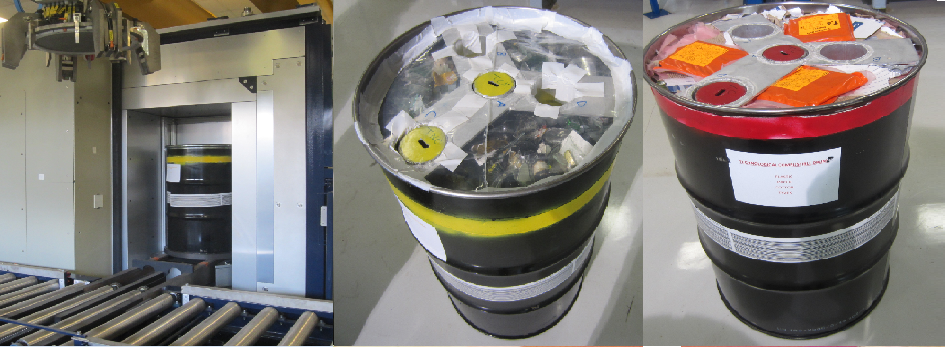
By means of non-destructive assay techniques.
As part of a European research project on metrology for nuclear decommissioning, we have put into operation two non-destructive assay stations at the Waste Characterisation Station on the JRC Ispra site and we have produced a Good practice guide for the validation of a waste characterisation system for very low, low, and intermediate level radioactive waste (coming soon).
Since the 1960s, nuclear research activities at JRC Ispra site (Italy) produce radioactive waste. Additionally, the decommissioning of some of the obsolete nuclear facilities is ongoing and produces more waste. We need to accurately characterise the waste stored in containers in terms of radioactive content to guarantee safe storage and to avoid unnecessary risk to the operators, the population and the environment. For this, we employ Non-destructive assay (NDA) instruments that can interrogate containers without destroying or modifying them, simply by measuring and analysing the emitted radiations.At JRC Ispra, we characterise the waste containers at the Waste Characterisation System (WCS) (Fig. 1) before directing them to the final disposal site.

What is new?
With our partners of the H2020 research project MetroDecom II, we have taken into operation the two main non-destructive assay systems of the Waste Characterisation System. We have described the lessons learned in the Good Practice Guide for the validation of a waste characterisation system for very low, low and intermediate level radioactive waste in order to share our experiences with the European decommissioning community.
Why is it important?
In Europe and worldwide the first generation of nuclear power plants and old nuclear research facilities are close to their end of life. This is increasing the production, conditioning, and disposal of radioactive waste. Therefore, it is important to improve the methodologies for radioactive waste analysis and the performance of assay systems.
As a partner of the MetroDecom II project, we have shared first-hand experience of the validation of the Waste Characterisation System with the European decommissioning community. This will help others designing and operating radioactive waste measurement systems and finally ensuring the safe disposal of radioactive waste.
How does it work?
The two Non Destructive Assay stations at the Waste Characterisation System are the passive/active neutron station and the segmented/tomographic gamma station. A complete characterisation of a waste container includes measurements at both stations.
The passive/active neutron station quantifies possible nuclear materials in the waste: passive neutron measurements determine the spontaneous fissile isotopes (e.g. 238Pu, 240Pu, and 242Pu), whereas active neutron measurements use an external neutron source to induce fission in the fissile isotopes (e.g. 235U, 239Pu and 241Pu).
The Segmented Gamma Scanning (SGS) and the Tomography Gamma Scanning (TGS) stations employ gamma-ray measurements of all radionuclides in the waste. In the SGS method, the container is divided into 16 pancake-like segments, whereas the TGS method uses even smaller sub-divisions, called voxels. In both methods, a gamma-ray transmission measurement is performed to determine the attenuation of gamma-rays through the waste volume. The final assay result is the amount of each radionuclide embedded in the waste.

To validate the methods utilised at the two stations, we produced adapted waste drums of non-radioactive matrix materials, with compositions similar to the waste categories used on the JRC Ispra site (cement, technological non-combustible, metal, glass, etc.). The adapted waste drums can accommodate radioactive or nuclear standard sources and they allow to test the performance of the methods (fig. 2).
Based on measurement campaigns on the adapted drums and on real waste containers, we have determined the minimum detectable activity and the measurement accuracy of the method were determined. The campaigns have also given insight into best practices that resulted in recommendations for the validation of measurements of waste characterisation systems in general. These results are summarised in the Good Practice Guide for the validation of a waste characterisation system for very low, low and intermediate level radioactive waste found on the JRC Publications Repository.
Related Content
JRC sites decommissioning activities
Nuclear Safeguards and Security
Characterisation of the gamma measurement station of the JRC Waste Characterisation System
Details
- Publication date
- 13 April 2021
